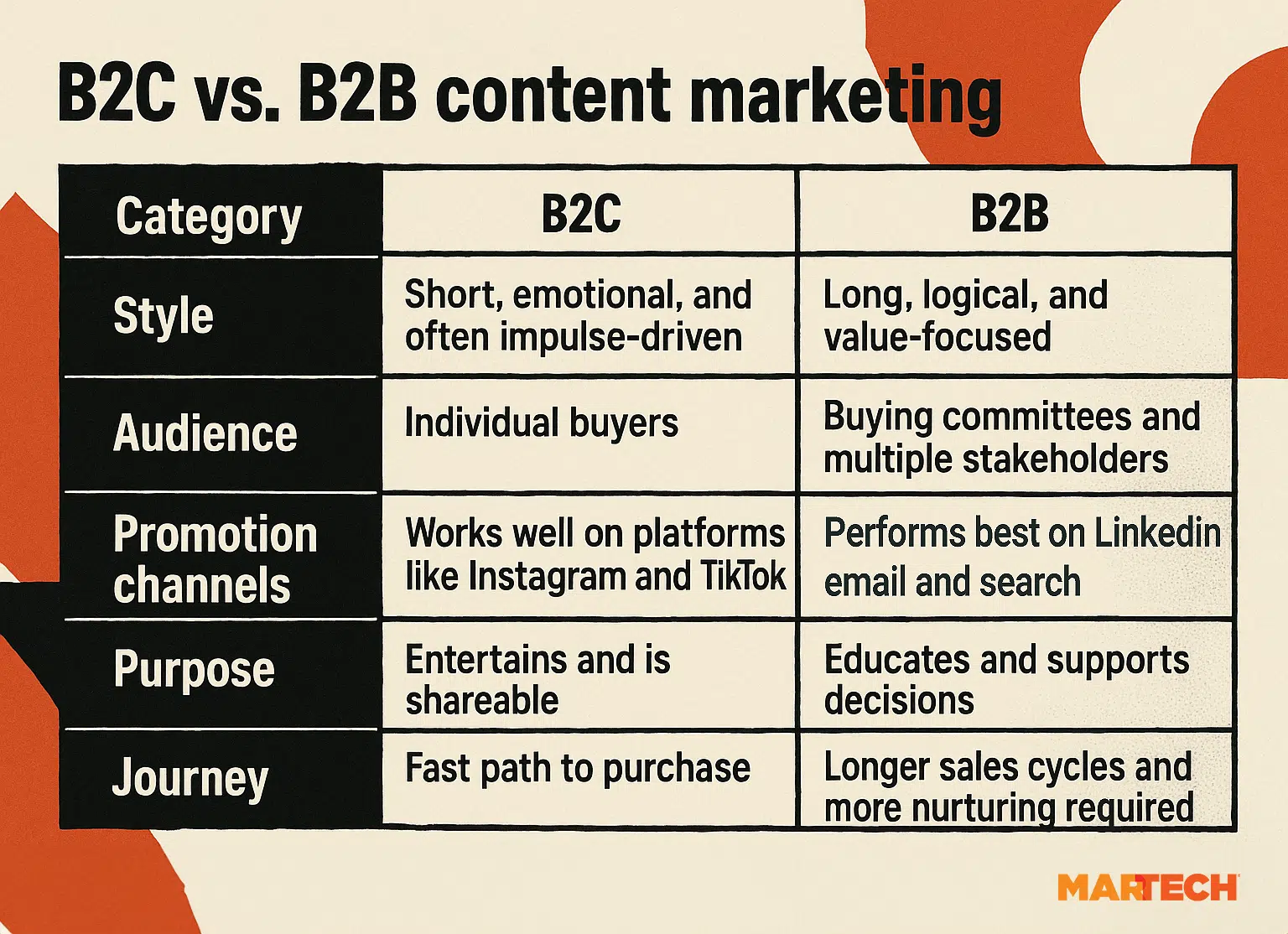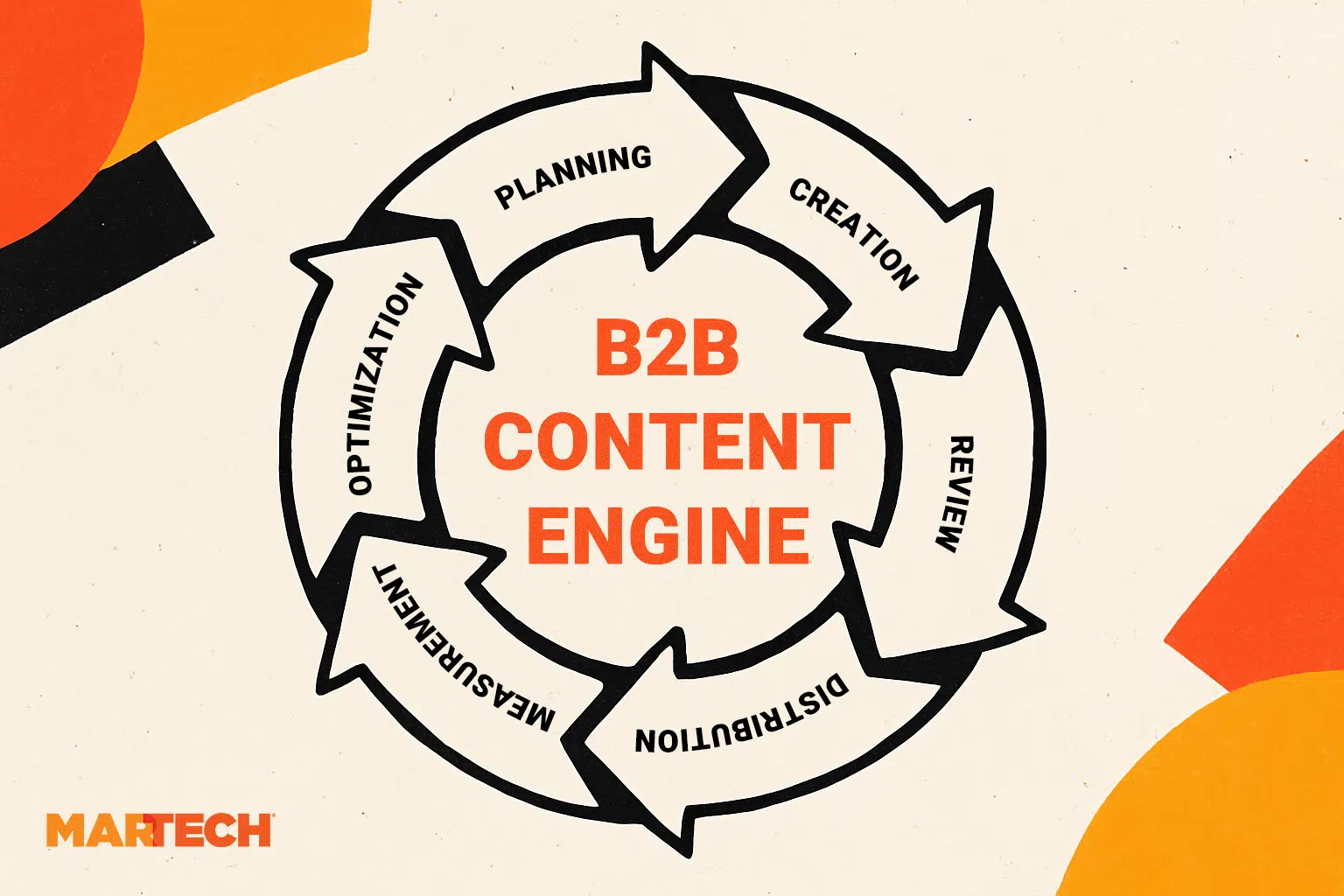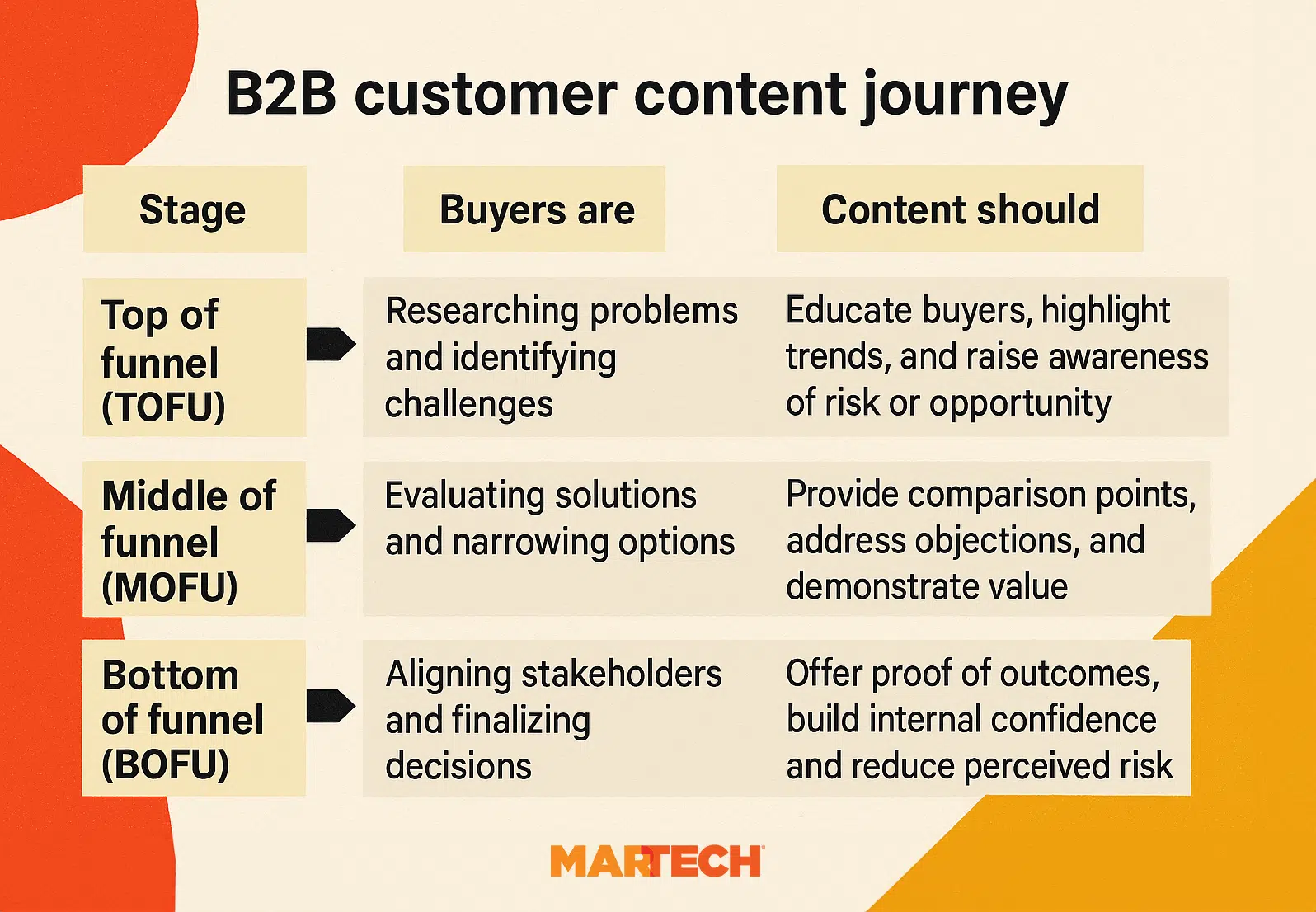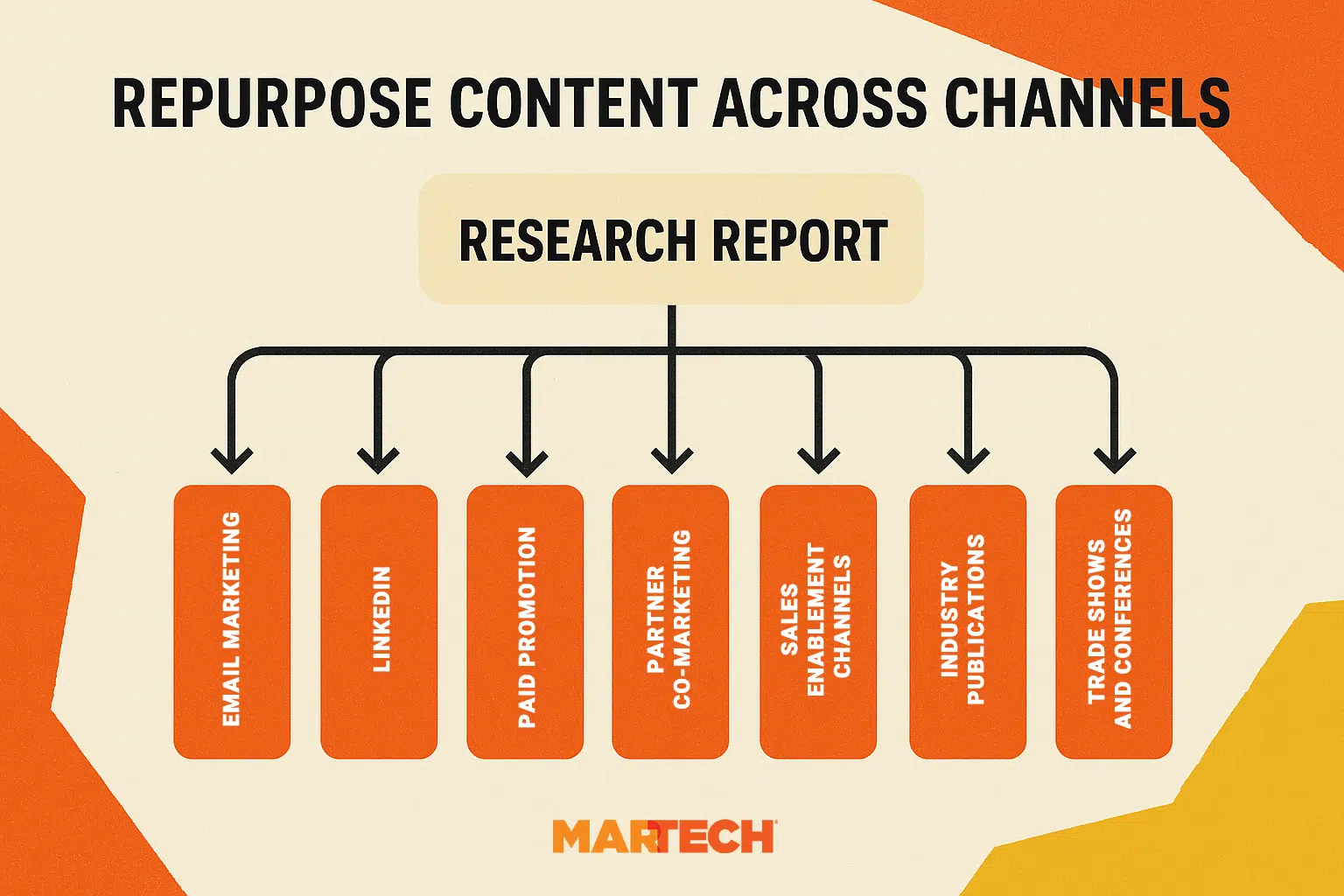A beginner’s guide to B2B content marketing that drives conversions
Learn how to build a B2B content marketing strategy that drives demand, aligns teams, and delivers ROI. A complete guide for enterprise marketers.
In business-to-business (B2B) marketing, content marketing must do more than fill a blog with fun stories. It needs to move the buyer’s journey.
Unlike business-to-consumer (B2C) content marketing, B2B is slower and more complex, and decisions usually involve multiple people, more research, and a bigger need to show the product works.
This guide explains what makes B2B content marketing work and how to build a strategy that delivers real results at scale.
What is B2B content marketing?
A strong B2B marketing strategy involves creating and distributing helpful, relevant content to attract business buyers, educate them, and influence their purchasing decisions.
While consumers often make quick, one-off purchases, B2B content marketing supports a much longer process. Buyers are evaluating multiple options in-depth, justifying the expense, and seeking approval from higher-ups before moving forward.
Here’s what changes:

Where B2C content might entertain or spark impulse buys, B2B content needs to educate, build trust, and support complex decision-making, often across multiple stakeholders.
Why B2B content marketing still works
Content marketing continues to be one of the most reliable strategies for driving measurable results in B2B marketing. According to a 2024 Content Marketing Institute report, B2B marketers say content has helped them in the following ways:
- 84% of B2B marketers say content helped create brand awareness
- 76% say it helped demand or lead generation
- 63% say it helped nurture subscribers, audiences, or leads
- 58% say it directly contributed to sales or revenue
These numbers reflect a growing confidence in high-quality content’s ability to support the entire buyer journey, from awareness to conversion.
B2B content marketing continues to work because it:
- Builds trust and credibility
- Supports long, self-directed buying cycles
- Provides enablement tools for marketing, sales, and customer success
- Aligns messaging across teams, markets, and regions
Pro tip: Map each content asset to a buyer journey stage. This aligns your team to create useful, meaningful content rather than just busywork. That’s why mapping content to the customer journey is so important. For more on aligning your funnel stages with content strategy, see this breakdown of the marketing funnel’s anatomy
Mapping content to the B2B buyer journey

While B2B buyer journeys are often framed in three stages similar to B2C (awareness, consideration, and decision), they may involve long evaluation cycles and multiple internal sign-offs.
In short, B2B content follows a different set of rules:
- It’s rarely one person making the decision. Purchases usually involve teams from finance, IT, operations, and leadership.
- Buyers aren’t just picking a product. They’re choosing a long-term solution that fits their business needs.
- Content has to do more than inform. It should also help buyers make the case to others inside their company.
How the journey typically breaks down in B2B:

What TOFU, MOFU, and BOFU look like in practice
Say you’re marketing cybersecurity software to enterprise buyers, your content plan could include:
- TOFU content: Create blog posts or infographics that help CISOs identify common gaps in endpoint protection. At this stage, buyers are just beginning to understand the problem, so focus on education and awareness without promoting your product directly.
- MOFU content: Offer white papers or comparison guides that explain how your solution handles emerging threats better than legacy systems. This helps buyers evaluate options while also collecting leads you can nurture through your pipeline.
- BOFU content: Share webinars or case studies featuring real customers, such as an IT director explaining how they rolled out your solution in under 30 days.
In B2B content marketing, buyers sell internally long before you close the deal and your content should help them make the case.
Pro tip: Use gated content to capture leads with high-value resources like reports or templates. Leave early-stage content such as blog posts or beginner guides ungated. You want to make it easy for new visitors to engage without barriers.
High-impact B2B content formats
In B2B marketing, each content type serves a specific role in helping buyers move through a long, complex decision process.
A webinar might spark interest, and a case study might close the deal. What’s important is using the right format at the right time, based on what your buyer needs to know, what stage they’re at, and who else they need to convince.
Here are the most effective formats in B2B content marketing today:
- Thought leadership: Build trust and authority by sharing your executives’ unique insights, industry predictions, or strategic POVs.
- Case studies: Offer real-world validation of your solution with data, quotes, and outcomes that reflect your target customer’s pain points.
- White papers: Provide depth and detail for technical audiences, procurement teams, or anyone looking for evidence during the evaluation stage.
- Webinars: Deliver education and engagement in real time. They’re great for capturing leads and building credibility through conversation.
- How-to guides and FAQs: Help potential customers understand how your product works and how it fits into their workflow by addressing real questions and showing practical use cases.
- Blog posts: Drive traffic through search, support early discovery, and provide shareable content for sales and social.
What a strong B2B content mix looks like
A company selling procurement software to enterprise finance teams might use types of content like:
- A thought leadership article on the future of spend management
- A webinar with a CFO discussing automation
- A case study from a global brand that reduced manual processes
- A gated checklist called “10 Things to Include in Your RFP”
Each format is helpful, but remember, it really only converts if it reaches the right person at the right time in their decision-making process.
Pro tip: Don’t create content just to check a box. Ask, “Where will this be used?” For insights on aligning content with buyer intent and business outcomes, see A better approach to B2B lead gen.
How to build a scalable B2B marketing content strategy
A good B2B content strategy creates alignment. A great one creates momentum.
When multiple teams (Sales, Marketing, Product, and Legal) are involved, content can become disconnected or inconsistent. A scalable strategy requires structure, workflows, and shared goals.
Here are the core elements every B2B content strategy should include:
1. Content governance
Define who owns what. This includes assigning roles for strategy, writing, editing, approvals, localization, and measurement. In enterprise settings, governance helps prevent off-brand content and meets legal or compliance needs.
Sample content ownership breakdown:
- Sales delivers details about the prospect’s pain points
- Marketing owns strategy, editorial planning, execution, benchmarks, and measurement
- Product marketing owns the messaging for new feature releases and the approval of drafts
- Legal reviews gated content and customer quotes
2. Cross-functional collaboration
Collaborate with Sales, Product, and subject matter experts (SMEs)—such as product managers, sales engineers, or technical leads—early through clear workflows in project management platforms.
Tactics that make collaboration work:
- Use SME interview templates to capture expert insights efficiently and turn them into content faster
- Create a shared content brief so everyone aligns on goals, messaging, and timelines
- Host monthly syncs with Sales to surface timely content needs and align on priorities
3. Content mix by goal
A successful B2B content marketing strategy maps different content types to specific business goals across the funnel. Your strategy should outline how content supports demand generation at the top of the funnel, sales enablement during evaluation, product adoption after purchase, and customer education for ongoing success.
You then iterate on future content marketing efforts using a data-driven approach, understanding how your existing content is reaching your target demographic to then pinpoint gaps and opportunities.
How different content formats support each funnel stage
- TOFU: Create SEO-driven blog posts, social media content, and thought leadership articles to attract new audiences and drive awareness.
- MOFU: Build one-pagers, gated comparison guides, case studies, and white papers to support evaluation and sales conversations.
- BOFU: Offer live product demos, walkthrough videos, customer testimonial videos, or detailed implementation timelines to help prospects feel confident about choosing your solution.
4. Calendar and campaign planning
A well-planned content calendar keeps teams on the same page and ensures your assets map to launch dates, events, or sales cycles. At the enterprise level, this calendar should also coordinate with global or regional teams.
How to plan campaigns that work together
- Use tools like monday to visualize your content creation workflow and spot potential bottlenecks
- Map out campaigns by funnel stage and goal so each piece builds on the last
- Plan for distribution from the start to avoid miscommunication and content roadblocks
- Look for overlaps across projects, regions, and channels to avoid overwhelming prospects with disconnected messages
Think of it like a group project. If everyone turns in their slides for a campaign report simultaneously without prior team communication on how to present, you end up with an uncoordinated and ineffective presentation. Planning ahead means each piece fits together and supports the bigger story.
Search Engine Optimization (SEO) for B2B content
B2B buyers rely on search more than ever, with 66% using internet search results to find information before purchasing. However, what they search for differs from what a B2C buyer might type. Instead of searching for the “best laptop,” they search for things like the “cybersecurity checklist for remote teams” or “how to reduce cloud costs for enterprise SaaS.”
You’re not just targeting high-volume keywords. You’re targeting high-intent queries, technical research, and long-tail searches that signal purchase readiness.
What to prioritize in B2B SEO content marketing:
- High-intent keywords: Focus on terms that reflect real business problems or comparisons (e.g., “best CRM for manufacturing teams” or “project management software RFP template”)
- Long-form content: Use complete guides and resource hubs to write great content addressing complex questions that can rank across related terms
- Bottom-of-funnel landing pages: Build SEO-friendly pages for specific use cases, industries, or product categories
- AI-ready formatting: Structure your content with clear headings, summaries, and lists so it appears in featured snippets and large language model (LLM)-powered tools like Google’s Search Generative Experience
- Internal linking: Connect pages with clear CTAs to help readers go deeper and to signal relevance and topic authority to search engines
SmileWorks Used Semrush to Benchmark Competitors and Grew 4,773%
✓ Compare your exact standing against local competitors
✓ Spot quick-fix visibility gaps in your market
✓ Find ranking opportunities competitors are missing
Free instant insights.
How to target high-intent B2B keywords
High-intent keywords help you connect with purchasers who know what they are looking for. Let’s say you sell workflow automation software. Instead of focusing on broad terms like “workflow tools,” you might uncover better opportunities with Semrush’s Keyword Magic Tool, which can help surface long-tail, high-intent search terms. You could then build a strategy to:
- Focus on a keyword like “automate invoice approval healthcare” to capture niche, solution-aware buyers
- Create a help article targeting “workflow automation integrations with Zoho” for technical researchers
- Build a product page optimized for “enterprise workflow automation software for finance teams” to meet buyers who are ready to evaluate vendors
These keywords may have lower search volume but reflect higher intent, lower competition, and more direct business value. You’ll produce more engaging content for a motivated audience.
Pro tip: Think about what the searcher wants. Use a blog or guide to answer early questions about your business, a detailed product page for buyers comparing options, and a help article to explain setup or integrations for those assessing the ease of migration.
B2B content distribution channels that work
In B2B content marketing, you’re not optimizing for virality or mass appeal. You’re optimizing for relevance, timing, and influence across a buying committee.
Here are the most effective B2B content distribution channels and how to use them:
- Email marketing: Segment by buyer persona, industry, or funnel stage. Use email newsletters for consistent touchpoints and automated nurture sequences to move leads forward. For examples of automated drip campaigns and lifecycle triggers, check out The Anatomy of Marketing Funnel Automation.
- LinkedIn: Share through both company pages and executive profiles. Carousel content performs well with 2.5 times more engagement than the average engagement earned by other content types.
- Paid promotion: Use Google Ads or display campaigns to reach specific job titles, industries, or intent-based audiences. Match your audience size to the funnel stage—think broader for top-of-funnel awareness and narrow your targeting for retargeting or decision-stage content.
- Partner co-marketing: Collaborate with trusted vendors, agencies, or integration partners to co-create and co-promote content. This expands your reach while borrowing credibility.
- Sales enablement channels: Equip your sales team with shareable content they can drop into follow-up emails, pitch decks, and live demos.
- Industry publications: Consider guest contributions or sponsored content in trusted trade media relevant to your industry to build thought leadership and visibility.
- Trade shows and conferences: Find the events your target audience cares about most. Use them to build real connections, hand out printed materials that explain what you do, and meet potential leads you can follow up with after the event.
How a full-funnel distribution plan comes together
A company that sells risk management software to financial institutions creates an original research report on upcoming regulatory changes and uses it across channels to engage, educate, and convert high-value prospects. Here’s how they might distribute this asset across channels.
- Email marketing: Share a research report your team conducted directly with CFOs, segmented by industry and company size.
- LinkedIn: Post a short executive video on a company leader’s profile discussing new regulatory industry shifts, followed by a carousel previewing the report’s insights.
- Paid promotion: Run a Google Ads campaign targeting “financial compliance software” and retarget past site visitors with a download offer for the report.
- Partner co-marketing: Co-host a webinar with a compliance partner to unpack the report’s findings, provide a live Q&A, and reach both of your audiences
- Sales enablement channels: Provide the sales team with a one-pager that breaks down the report’s highlights, ready to use in demos or follow-ups.
- Industry publications: Pitch a bylined article summarizing trends from the report to a leading finance trade journal to boost visibility and credibility.
- Trade shows and conferences: Distribute printed summaries of the report at a financial compliance conference, and use QR codes to drive attendees to the full version online.

Now you have content working across email, social, sales, and partnerships in a way that builds momentum. More B2B marketers are leaning into this approach so their content appears when buyers actively decide whether to purchase their product or service.
How to measure B2B content marketing performance
In B2B marketing, success is about how your content influences the pipeline, accelerates sales, and supports revenue goals across the organization.
Metrics that matter in B2B:
- Influenced pipeline: Track how often specific assets are viewed, downloaded, or shared during active deals.
- Lead quality: Don’t just count leads—evaluate whether they align with your ideal customer profile, job titles, and firmographics.
- Engagement depth: Go beyond time on page. Use scroll depth, content downloads, repeat visits, and session duration to assess true interest.
- Attribution: Apply multi-touch attribution to see how content contributed to opportunity creation or deal acceleration, even if it wasn’t the final click.
- Return on investment (ROI): Compare your content production and promotion costs against pipeline influenced, revenue closed, or sales velocity gains.
Where to get these insights
You don’t need to build a custom solution from scratch. Most of these metrics can be pulled from tools you likely already use:
- CRM platforms like Salesforce and HubSpot show attribution and pipeline influence. (Ask your sales or marketing team for access if you don’t have it.)
- Marketing automation tools like ActiveCampaign offer lead scoring, engagement, and funnel tracking. For a detailed breakdown on integrating martech tools, read The anatomy of marketing funnel automation.
- Web analytics tools like Google Analytics 4 display scroll depth, time on page, and goal conversions. (Free to use with your website).
- Content performance platforms like Uberflip track asset-level performance. (If unavailable, track page views and downloads manually.)
- Revenue intelligence dashboards built in Excel track ROI and performance across content types and teams.
Pro tip: Collaborate with Sales Ops or Marketing Analytics to make sure content reporting is tied to the same KPIs your leadership team is watching.
Real-world workflow for tracking content ROI
We can see how valuable this approach is if we consider a SaaS company, as it uses reporting tools across its marketing and sales stack to track performance:
- Salesforce tags high-value deals that interact with key content assets like white papers or ROI calculators
- ActiveCampaign, tracks which nurture emails have the highest conversion rate from marketing-qualified leads (MQLs) to sales-qualified leads (SQLs)
- Google Analytics 4 measures scroll depth and session duration to see which blog posts drive deeper engagement
- Excel compiles monthly dashboards that show which gated assets influenced the pipeline by role, region, and industry
These insights allow the team to prioritize formats that actually support revenue and scale what’s working.
Common B2B content mistakes to avoid
Even well-intentioned B2B teams fall into content traps where scale, speed, and stakeholder alignment are constant challenges.
Here are a few common mistakes to watch for:
- Lack of ownership: Remember, without a clear content owner, assets get delayed, duplicated, or drift off-brand. Establish roles early for strategy, writing, editing, approval, and distribution.
- Product-first messaging: Leading with features instead of pain points often misses the mark. Your audience needs to know you understand them before they care about capabilities.
- Siloed efforts: Content created in isolation by different teams can confuse your audience and dilute your messaging. Connect calendars, workflows, and approvals across departments.
- Underused assets: High-performing content often gets published once and forgotten. Repurpose blog posts into social content, turn webinars into guides, and reshare case studies quarterly.
- No plan for distribution: Publishing without promotion is like whispering into the void. Map out how and where each piece of content will be shared before it’s created.
Avoiding these common missteps won’t just improve your content; it’ll make your strategy easier to execute, scale, and become more effective across your entire go-to-market (GTM) team.
Pro tip: One of the biggest missed opportunities in B2B content is not extending the life of what you’ve already created. A single blog post, webinar, or white paper can fuel five or more assets if you plan for reuse early. Integrate repurposing into your workflow to avoid content gaps while maintaining a consistent and scalable message.
Why B2B content marketing strategy matters
B2B buyers are overwhelmed with content, and their attention is limited. That’s why having a thoughtful content strategy is a necessity.
A strong B2B content strategy helps you:
- Attract the right audience with content that speaks directly to their problems
- Support every stage of the buyer journey with helpful, relevant assets
- Build alignment across teams so messaging is consistent across regions, products, and sales plays
- Prove impact by connecting content to pipeline, lead quality, and revenue
- Create repeatable systems that scale with your business instead of starting from scratch every time
Focus on creating B2B content that moves your buyer forward, builds trust in your business, and helps them make a strong case to internal decision-makers. For next steps on eliminating the manual lift behind that process, explore the anatomy of marketing funnel automation to see how your content fits into a scalable, automated strategy.